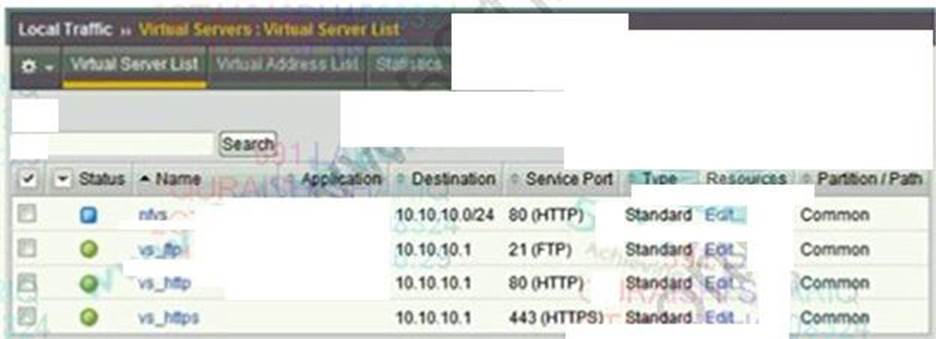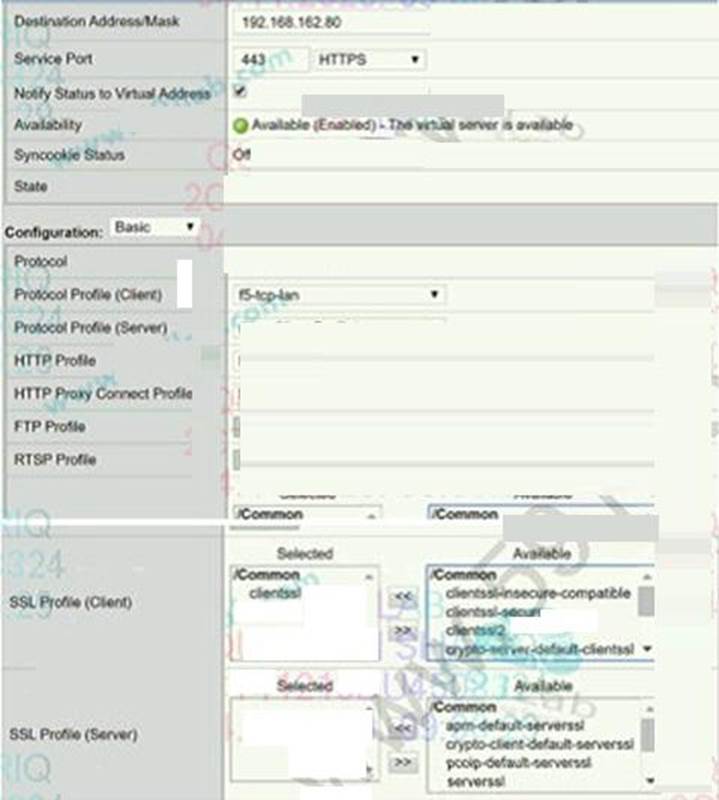F5 201 TMOS Administration Online Training
F5 201 Online Training
The questions for 201 were last updated at Nov 19,2024.
- Exam Code: 201
- Exam Name: TMOS Administration
- Certification Provider: F5
- Latest update: Nov 19,2024
A BIG-IP device has only LTM and ASM modules provisioned. Both have nominal provisioning level. The BI6-IP Administrator wants to dedicate more resources to the LTM module. The ASM module must remain enabled.
Which tmsh command should the BIG-IP Administrator execute to obtain the desired result?
- A . modify/sys provision asm level minimum
- B . modify /sys provision Itm level dedicated
- C . modify /sys provision asm level none
- D . modify /sys provision Itm level minimum
The BIG-IP appliance fails to boot. The BIG-IP Administrator needs to run the End User Diagnostics (EUD) utility to collect data to send to F5 Support.
Where can the BIG-IP Administrator access this utility?
- A . Console Port
- B . Internal VLAN interface
- C . External VLAN interface
- D . Management Port
Some users who connect to a busy Virtual Server have connections reset by the BIG-IP system. Pool member resources are NOT a factor in this behavior.
What is a possible cause for this behavior?
- A . The Connection Rate Limit is set too high
- B . The server SSL Profile has NOT been reconfigured.
- C . The Connection Limit is set too low.
- D . The Rewrite Profile has NOT been configured.
For a given Virtual Server, the BIG-IP must perform SSL Offload and negotiate secure communication
overTLSvl.2only.
What should the BIG-IP Administrator do to meet this requirement?
- A . Configure a custom SSL Profile (Client) and select no TLSvl in the options list
- B . Configure a custom SSL Profile (Client) with a custom TLSV1.2 cipher string
- C . Configure a custom SSL Profile (Server) and select no TLSvl in the options list
- D . Configure a custom SSL Profile (Server) with a custom TLSV1.2 cipher string
A BIG-IP Administrator plans to upgrade a BIG-IP device to the latest TMOS version.
Which two tools could the administrator leverage to verify known issues for the target versions?
(Choose two.)
- A . F5 University
- B . F5 Downloads
- C . F5 End User Diagnostics (EUD)
- D . FSiHealth
- E . F5 Bug Tracker
A BIG-IP Administrator remotely connects to the appliance via out-of-band management using https://mybigip mycompany net. The management portal has been working all week. When the administrator attempts to login today, the connection times out.
Which two aspects should the administrator verify? (Choose two)
- A . DNS is property resolving the FQDN of the device.
- B . The device is NOT redirecting them to http.
- C . The administrator has the latest version of the web browser.
- D . Packet Filters on the device are blocking port 80.
- E . The administrator has TCP connectivity to the device.
Refer to the exhibit.

A user attempts to connect to 10.10.10.1.80 using FTP over SSL with an FTPS client.
Which virtual server will match and attempt to process the request?
- A . vsjutps
- B . vs_ftp
- C . vs_http
- D . nvfs
An ecommerce company is experiencing latency issues with online shops during Black Friday’s peak season.
The BIG-IP Administrator detects an overall high CPU load on the BIG-IP device and wants to move the
top utilized Virtual Servers to a dedicated BIG-IP device.
Where should the BIG-IP Administrator determine the problematic Virtual Servers?
- A . System > Plattform
- B . Local Traffic > Virtual Servers > Virtual Server List
- C . Local Traffic > Network Map
- D . Statistics > Module Statistics > Local Traffic > Virtual Servers
A BIG-IP Administrator applied the latest hotfix to an inactive boot location by mistake, and
needs to downgrade back to the previous hotfix.
What should the BIG-IP Administrator do to change the boot location to the previous hotfix?
- A . Uninstall the newest hotfix and reinstall the previous hotfix
- B . Reinstall the base version and install the previous hotfix
- C . Reinstall the previous hotfix and re-activate the license
- D . Uninstall the base version and restore the UCS
Refer to the exhibit.

A BIG-IP Administrator needs to deploy an application on the BIG-IP system to perform SSL offload and
re-encrypt the traffic to pool members.
During testing, users are unable to connect to the application.
What must the BIG-IP Administrator do to resolve the issue?
- A . Remove the configured SSL Profile (Client)
- B . Configure Protocol Profile (Server) as splitsession-default-tcp
- C . Enable Forward Proxy in the SSL Profile (Client)
- D . Configure an SSL Profile (Server)
Latest 201 Dumps Valid Version with 166 Q&As
Latest And Valid Q&A | Instant Download | Once Fail, Full Refund

